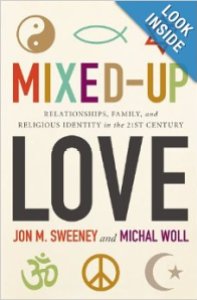I was not initially excited by the book, Mixed Up Love, written by Jon Sweeney and Michal Woll, telling  about their interfaith union. For while I am all for sharing stories about successful intermarriage (being in one for over 25 years), I was not sure what the hype was about. But as I read and reflected on what they had to say and experienced, I came to appreciate the nuances of their story and the courage of their commitment. It is one that stands on the cusp of a larger opportunity.
about their interfaith union. For while I am all for sharing stories about successful intermarriage (being in one for over 25 years), I was not sure what the hype was about. But as I read and reflected on what they had to say and experienced, I came to appreciate the nuances of their story and the courage of their commitment. It is one that stands on the cusp of a larger opportunity.
Not only is one partner in this interfaith marriage Jewish, but she is also a Rabbi. This alone was not enough to bowl me over as there are many intermarried clergy who faced similar situations. I too am ordained but as an Interfaith Minister. My seminary was founded by an Orthodox Jewish Rabbi AND I completed the coursework for Rabbinic Seminary International. BUT…while I do run an educational program for children of interfaith marriage, I do not serve the congregation of a denomination approved by a religious institution that beholds me to the politics that go with it. Michal does. And this makes all the difference. Furthermore, Jon’s devotion to Catholicism is as deep as Michal’s is to Judaism. He converted to Catholicism as an adult, having been raised a Protestant. He is a religious scholar and author of multiple books on Christianity and Catholicism.
The profundity of Jon and Michal’s situation did not hit me until I read the following words – not in their book but in Being Both about families choosing two religions and their difficulty in finding supportive clergy. “Jews who are intermarried or in a committed relationship with a non-Jew cannot be admitted to or ordained by the rabbinical seminaries of the Conservative, Reform, or Reconstructionist movements… rabbinical students deeply involved with Christian partners…felt they had to push their partners to convert to Judaism by the time of their ordination.” (p. 73)
Ouch.
Even though I “knew” this (never mind the Orthodox movement’s ban on intermarriage let alone female rabbis), there was something definitive and sad about reading it in black on white. It made me see the decree for what it is. Although Michal, who met Jon after becoming a rabbi, does not confront these rules pre-ordination, she does so post-ordination. I came to see her predicament as part of a pregnant moment waiting to give birth to a new paradigm.
Jon and Michal’s story is testimony to Love’s conquering power. They describe their religious and romantic backgrounds in a refreshing style with honesty and clarity. They share the process by which they, alone and together, work out differences and celebrate similarities. We learn of two people with strong and admirable values from theologically opposing traditions and histories punctuated by conflict. Yet, they manage to love the stranger.
They have chosen to keep a Jewish home and raise their daughter with one faith (Jewish), while Michal is supportive of Jon’s Catholicism. Not all intermarried couples have or will come to the same conclusions, but I know that many share in equally spiritually-enriching conversations about religion. This couple’s willingness to expose theirs and to demarcate their journey with themes such as “becoming ourselves” and “creating a home” offers inspiration to others.
When Jon’s religious affiliation turns out to be the sole reason for why Michal is rejected by one Jewish congregation to become their rabbi, it says more about that congregation than about them. She later lands a position with a congregation that accepts her Catholic spouse. (Kol haKavod / All the Honor to these Jewish Reconstructionists.)
I am thrilled that this family has a religious home where they can feel comfortable and grow together. However, just as Michal’s dual role of rabbi and interfaith spouse presented a hurdle for finding a congregation to lead and a community to join, so too is her binary identity a boon. For the result of this love story is an interfaith married rabbi bearing the conferred power to be both The Acceptor and The Accepted, The Leader and The Led.
Feel free to see my Resources for implementing or developing an educational program that serves interfaith minded families and congregations.